






AS summer kicks into gear, species such as estuary cod, mangrove jack, threadfin salmon, snapper, grass sweetlip, spangled emperor, tuskfish, moses perch, trevally and other pelagics come into play. Most of the reef species can be found around the bay islands, artificial reefs and in the Brisbane River, while pelagics are found in more open waters.
The shipping channel, Rous, Rainbow and Pearl channels are the fish highways into the bay, and the eddies that form around the beacons often hold bait as they shelter from the current. This is particularly true for school mackerel, and on occasions cobia and kingfish.
The best beacons are those in 15m or more, but all beacons off Moreton Island are worth a try. If after a few passes you have not raised a fish, move to the next beacon because you can always come back later and give it a try. To fish these beacons, position the boat up-current so it drifts past the beacon by 5-10m, and when you near the beacon, drop your chrome slug of around 60g towards the bottom then crank it back as fast as possible. Summer Bay
A high-speed spin reel on a 7’ rod is my gear of choice, and metal lures from Lazer Lures, Halco or Spanyid are proven catchers. I find a single hook gives you a better hook-up rate and most hits will come within the first 5m off the bottom. Occasionally you’ll get a hit halfway back to the boat, so be mindful to slow your retrieve down as you come close to the surface, otherwise you could damage your guides.
You can also anchor up-current and float live bait or pillies back towards the beacon. Beacons from the Four Beacons north are the better beacons to attack and the Measured Mile beacons are great if specifically targeting school mackerel. Beacons from Curtain north are the ones you have a chance of attracting cobia or kingfish, with floated baits or stick baits.Summer Bay
The other areas to try for doggies are the Amity Bank drop-offs or the top and bottom of the Pearl, Rous and Rainbow channels. Spotted mackerel do not hang around beacons, but it is a little early to be finding spotties in the bay because they usually turn up from January onwards, when most other pelagic activity in the bay increases.
Birds are the best option for finding feeding pelagics. If you find the birds, the fish will be below, even if the birds are spiralling upwards in the one area or moving slowly looking down. Birds flying higher up means the fish are deeper. On occasion, birds may be feeding on bait without accompanying pelagics or the fish can be feeding with no birds in sight.
A few of the better places you will find birds are from the Sandhills across to Mud Island, the Rous across to Green Island or from the Measured Mile to Mud Island. A trip up the Rous or Rainbow channels can often see you coming across feeding pelagics. A month ago, there was even a school of tuna feeding in the mouth of the river.Summer Bay
Tuna are finicky feeders, so it’s usually better to use smaller slugs in the 30-40g range, but it pays to carry two outfits, one rigged with said weight and another rigged with about an 80g option. Tuna usually feed into the wind, and with this knowledge it’s easy to work out which way the feeding school is travelling. As a bonus, you’ll often find bonito in among the tuna schools.Summer Bay
Both tuna and mackerel are surface feeders, and it is easy to tell the difference because tuna breach the surface more while mackerel stay below the surface. If you find a feeding frenzy, motor up and stay around 10m to the side with your motor running, cast to the edges of the school and retrieve like hell back to the boat. One thing about mackerel is that their feed and travel routine can usually be worked out easily and you can position the boat ahead of the school, so they come toward you.
All mackerel once caught should be subdued with a donger, bled, then iced as soon as possible. Longtails should be turning up in better numbers between Coochiemudlo and Peel islands, the Rainbow Channel, Peel to the Sandhills, the shipping channel and from the Pearl Channel down to Mud Island. Work the edges of the drop-offs trolling pillies or live bait on a paravane or downrigger.Summer Bay
You could on occasions find them feeding on the surface and again birds will often help you find them. I was fishing on the 10m drop-off at Mud and had a longtail take a bait intended for snapper, so they are a fish that can pop up anywhere but they mainly herd bait up against the side of banks or drop-offs. Lures also work, with presentations such as 7’’ Z-Man Scented Jerk ShadZ in natural colours rigged on 1/2 or 3/4oz jig heads and 100-140m stick baits.
If you cannot get your hands on some livies, try the 220mm Zerek Affinity or Jackall Dowzswimmer swimbaits in natural colours. When targeting pelagics, especially longtails, make sure your gear is up to scratch, knots are well tied and you’re using a decent leader, as they will test your gear to its limits. I usually run 30lb braid with a 40lb leader, and anyone who has experienced the initial run will attest to their ability to make you wonder if you’re going to have enough line.Summer Bay
You may need to follow the fish to retrieve a little line back, and if you intend to keep the fish, they need to be brain spiked, bleed, then put straight onto ice to retain their eating qualities. Snapper can be caught in a multitude of places in the bay but favour areas where structure is close by. During summer I like to fish the shallows, especially into the evening on a dark night and early morning before the suns come up. I prefer to use fresh bait.
You may be lucky and catch a 70-80cm fish, but most will be in the 40-60cm range and these can easily be baked whole. There are plenty of small sharks, barracuda and grinner around at present – keep the grinner for the snapper because they don’t mind a fillet of this fish.Summer Bay
A few of the areas to try are:
- West Peel Artificial Reef at Latitude (DDM): 27° 30.002’S; Longitude (DDM): 153° 18.715’E
- The Tiwi Pearl wreck at Latitude (DDM): 27° 24.532’S; Longitude (DDM): 153° 18.304’E
- Curtain Reef at Latitude (DDM): 27° 06.600’S; Longitude (DDM): 153° 21.750’E
- Scarborough Reef
- The area down towards the Grazier wreck around Mud Island at Latitude (DDM): 27° 18.757’S; Longitude (DDM): 153° 15.028’E
- Coochiemudlo Artificial Reef at Latitude (DDM): 27° 34.222’S; Longitude (DDM): 153° 20.961’E.
By sounding around these marks, you will find more structure to search for snapper, grass sweetlip, spangled emperor, tuskfish and even the odd nannygai. Most of the artificial reef GPS marks are available on the Queensland Department of Agriculture and Fisheries website.
The eastern side of Green Island, the Wellington Point drop-offs and the rock wall at the top of Macleay Island are other areas to try, and there are a few isolated structures north of the Measured Mile to the southern end of the Pearl Channel. Even the edges of the shipping channel from Tangalooma up to Bulwer are worth having a sound around.
Curtain Reef is holding a lot of trevally at present. The eastern side of the Rainbow Channel from Myora north along the drop-offs is best fished a few hours either side of the top and bottom tide due to the current, and a downrigger will help fish the stronger current, where you can often find the odd tuskie or spangled emperor.Summer Bay
All the above areas are great places for early morning or evening sessions, especially on tide changes during weekdays, otherwise you have to contend with crowds on the weekend. Even the shipping channel edges north of Bulwer are worth a try, as there are isolated coffee rocks structures all the way up to Caloundra and jigging these areas when you find bait will put you in with a chance of finding cobia, spanish mackerel and kingfish.
A couple of these structures hold snapper, tuskies and particularly grass sweetlip. Keep an eye on the weather though, as you are in open waters and not protected by Moreton Island. You’ll need to have the correct safety gear on board, and this applies to when you’re in Moreton Bay also, which has calm and partially smooth waters. The Brisbane River is fishing better now than it has in years, with king threadfin salmon being caught as far up as St Lucia.Summer Bay
Cod, snapper, bream and the odd summer jewfish are also there for the taking. Snapper have been found along both sides of the drop-offs from Clara Rocks down to the rock walls around the mouth. If you’re after live bait, Boggy Creek, the small bay near the water treatment outlet, or the mouths of Bulimba and Norman creeks are good places to try.
Pike can be jigged up near the Coffee Pots and its worth looking around the outer beacons towards the mouth, as there’s also the odd squid at the end of the rock wall. Plastics in the river have been doing a lot of damage and they are worth a try at a few of the above marks. Winter whiting are still available around Fishermans Gutter or the weed beds in the Rous Channel.
Good quality summer whiting are around the Hope, Pelican and Chain banks, the southern corner of the Amity banks to the Rainbow Channel, around Hayes Inlet, the Pine River and Golden Beach at Bribie Island. While fishing around the entrance to the Rous Channel, you could have a go for squid, as the weed beds are still holding good quality models and mainly arrow.Summer Bay
Sand crabs are around in reasonable numbers and can be found from the Pearl Channel back towards Cockle Banks and the area around the Measured Mile down to the top of Mud Island. Even though winter is over, bream are still available and places such as the river, the eastern side in close and northeast corner of Mud, the western side of Green, the northern side of Coochie and the pylons around Dunwich, the Pine River, Hayles Inlet, and Lota and Tingalpa creeks are holding good fish.
The further south you go past Macleay Island, the more bream you’ll find, with bream around most of the mangrove lined islands. There are still plenty of flathead on the flats at Wynnum, the western side of Green, King Island and the southern end of the boat passage, and the mouths of Lota and Tingalpa creeks.Summer Bay
Though for better numbers of flathead head to Hayes Inlet, the Caboolture River, the Pine River, Nudgee, or the sand banks in Burpengary Creek and the mouth of Pumicestone Passage. So, get out early and chase reef fish, then go looking for pelagics, keeping an eye on the skies for circulating birds and you could come home with a mixed bag.
Here’s hoping spotties turn up in better numbers this year, as they’re already in Hervey Bay. The Queensland Department of Agriculture and Fisheries have released a new app ‘Qld Fisheries 2.0’, which will give you all the relevant rules and fish identification.
 Bush ‘n Beach Fishing Magazine Location reports & tips for fishing, boating, camping, kayaking, 4WDing in Queensland and Northern NSW
Bush ‘n Beach Fishing Magazine Location reports & tips for fishing, boating, camping, kayaking, 4WDing in Queensland and Northern NSW









